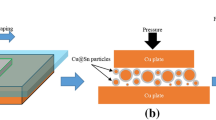Abstract
To fabricate electronic packaging shell of copper-matrix composite with characteristics of high thermal conductivity and low thermal expansion coefficient, semisolid forming technology, and powder metallurgy was combined. Conventional mechanical mixing of Cu and SiC could have insufficient wettability, and a new method of semisolid processing was introduced for billets preparation. The SiC/Cu composites were first prepared by PM, and then, semisolid reheating was performed for the successive semisolid forging. Composite billets with SiC 35 % volume fraction were compacted and sintered pressurelessly, microstructure analysis showed that the composites prepared by PM had high density, and the combination between SiC particles and Cu-alloy was good. Semisolid reheating was the crucial factor in determining the microstructure and thixotropic property of the billet. An optimised reheating strategy was proposed: temperature 1,025 °C and holding time 5 min.







Similar content being viewed by others
References
Chen XR, Zhang ZF, Xu J. Effects of A-EMS processing parameters on semisolid slurry production. Rare Met. 2011;30(2):195.
Efe GFC, Altinsoy I, Ipek M, Zeytin S, Bindal C. Some properties of Cu–SiC composites produced by powder metallurgy method. Kovove Mater. 2011;49(2):131.
Zhu GL, Xu J, Zhang ZF, Liu GJ. Semisolid microstructure evolution of AZ91D alloy under high shear rate. Rare Met. 2011;30(1):99.
Shu K-M, Tu GC. The microstructure and the thermal expansion characteristics of Cu/SiCp composites. Mater Sci Eng. 2003;A349:236.
Meng H. Investigation on SiCp/Cu composite electronic packaging shell by thixo-forging. University of Science and Technology Beijing; 2010.
Zhu J, Liu L, Hu G, Shen B, Hu W, Ding W. Study on composite electroforming of Cu/SiCp composites. Mater Lett. 2004;58(10):1634.
Lapkowski W. Some studies regarding thixoforming of metal alloys. J Mater Process Technol. 1998;80–81:463.
Sundberg G, Paul P, Sung C. Fabrication of CuSiC metal matrix composites. J Mater Sci. 2006;41(2):485.
Wang F. Numerical simulation and experiment verification of electronic packaging shell by thixo-forming. University of Science and Technology Beijing; 2010.
Barmouza M, Asadia P, Givia MKB, Taherisharghb M. Investigation of mechanical properties of Cu/SiC composite fabricated by FSP: effect of SiC particles’ size and volume fraction. J Mater Sci Eng A. 2011;528(3):1740.
Yuanyuan H, Hong G, Fazhang Y, Zhang X, Chu K, Fan Y. Microstructure and thermal conductivity of copper matrix composites reinforced with mixtures of diamond and SiC particles. Rare Metals. 2012;31(1):58.
Efe GC, Zeytin S, Bindal C. The effect of SiC particle size on the properties of Cu–SiC composites. Mater Des. 2012;36:633.
Nikolopoulos P, Agathopoulos S, Angelopoulos GN, Naoumidis A, Grübmeier H. Wettability and interfacial energies in SiC2 liquid metal systems. J Mater Sci. 1992;27:139.
Zhang L, Qu X, Duan B, He X, Qin M, Ren S. Wettability and pressureless infiltration mechanism in SiC–Cu systems. Int J Miner Metal Mater. 2009;16(3):327.
Li SS, Wang HL, Liu RY, Fan BB, Wang CH, Wu YS, Zhang R. Effect of different processes on SiC/Cu composites interface bonding. Rare Metals Mater Eng. 2007;36(1):689.
Acknowledgments
This study was financially supported by the National Natural Science Foundation of China (No. 51174028) and the Beijing Natural Science Foundation (No. 2102029).
Author information
Authors and Affiliations
Corresponding author
Rights and permissions
About this article
Cite this article
Wang, KK. Semisolid forging electronic packaging shell with silicon carbon-reinforced copper composites. Rare Met. 32, 191–195 (2013). https://doi.org/10.1007/s12598-013-0027-z
Received:
Revised:
Accepted:
Published:
Issue Date:
DOI: https://doi.org/10.1007/s12598-013-0027-z




